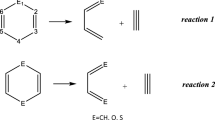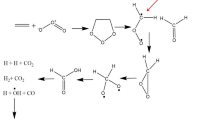Summary
-
1.
It is shown that, on splitting off the elements of hydrogen halide by the aid of alcoholic potash from the hydrohalic esters of dimethylneopentylcarbinol [2-Cl(I)-2,4,4-trimethylpentane], the hydrogen that is necessary for the formation of the hydrogen halide splits off from the most highly hydrogenated carbon atom from the methyl, and not the methylene group; i.e., contrary to Zaytsev's rule.
-
2.
This departure from Zaytsev's rule concerning the order of the splitting-off of the elements of hydrogen halide from monohalo derivatives of hydrocarbons of the CnH2n+2series is at present the only exception and is to be explained by the presence of the neopentyl radical; in just the same way the addition of hydrogen bromide to neopentylethylene in a manner contrary to Markovnikov's rule appears also to be the only exception to the rule.
-
3.
The amount of the β-form in diisobutylene depends on the conditions of preparation. Diisobutylene prepared according to Butlerov's method contains the greatest amount of the β-form (∼20%), and a considerably lower amount is obtained by splitting HCl with the aid of alcoholic alkali off 2-Cl-2,4,4-trimethylpentane (∼10%) and off 2-I-2,4,4-trimethylpentane.
Similar content being viewed by others
Literature cited
V.V.Markovnikov. Material Concerning the Mutual Influence of Atoms in Chemical Compounds. 96, Kazan, 1869.
Ogonowsky. Ber., 36, 1988 (1903).
Delaer. Bull.Acad.roy.Belg., 7 (1906); Chem.Soc.Abs., 90 (1), 476 (1906).
Whitmore and Homeyer. J.Am.Chem.Soc., 55, 4555 (1933).
A.P.Eltekov. J.Russ.Phys.Chem.Soc., 9, 386 (1877).
A.M.Zaytsev, J.Russ.Phys.Chem.Soc., 7, 289 (1875).
E.E.Vagner. Oxidation Reactions of Unsaturated Carbon Compounds. 47, Warsaw, 1888.
A.E.Favorsky. Selected Works. Moscow-Leningrad, 1940, p. 70.
A.M.Butlerov. J.Russ.Phys.Chem.Soc., 9, 41 (1877); 14, 199 (1882).
N.A.Prilezhaev. J.Russ.Phys.Chem.Soc., 39, 769 (1907).
F.Whitmore and Menier, J.Am.Chem.Soc., 55, 372 (1933).
A.P.Meshcheryakov, M.I.Batue, and A.D.Petrov. Bull.Acad.Sci.USSR, Div. Chem.Sci., 3, 282 (1950).
Author information
Authors and Affiliations
Rights and permissions
About this article
Cite this article
Mescheryakov, A.P., Petrova, L.V. The splitting-off of the elements of hydrogen halide from monohalo derivatives of hydrocarbons of the series CnH2n+2 . Russ Chem Bull 1, 165–169 (1952). https://doi.org/10.1007/BF01176585
Received:
Issue Date:
DOI: https://doi.org/10.1007/BF01176585




